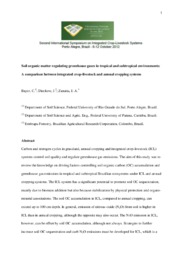Soil organic matter regulating greenhouse gases in tropical and subtropical environments: a comparison between integrated crop-livestock and annual cropping systems.
Soil organic matter regulating greenhouse gases in tropical and subtropical environments: a comparison between integrated crop-livestock and annual cropping systems.
Author(s): BAYER, C.; DIECKOW, J.; ZANATTA, J. A.
Summary: Carbon and nitrogen cycles in grassland, annual cropping and integrated crop-livestock (ICL) systems control soil quality and regulate greenhouse gas emissions. The aim of this study was to review the knowledge on driving factors controlling soil organic carbon (OC) accumulation and greenhouse gas emissions in tropical and subtropical Brazilian ecosystems under ICL and annual cropping systems. The ICL system has a significant potential to promote soil OC sequestration, mainly due to biomass addition but also because stabilization by physical protection and organo-mineral associations. The soil OC accumulation in ICL, compared to annual cropping, can extend up to 100 cm depth. In general, emission of nitrous oxide (N2O) from soil is higher in ICL than in annual cropping, although the opposite may also occur. The N2O emission in ICL, however, can be offset by soil OC accumulation, although not always. Strategies to further increase soil OC sequestration and curb N2O emissions must be developed for ICL, which is a system that is being encouraged in Brazil because of the many ecosystem services and economical benefits that it provides.
Publication year: 2012
Types of publication: Paper in annals and proceedings
Unit: Embrapa Forestry
Observation
Some of Embrapa's publications are published as ePub files. To read them, use or download one of the following free software options to your computer or mobile device. Android: Google Play Books; IOS: iBooks; Windows and Linux: Calibre.
Access other publications
Access the Agricultural Research Database (BDPA) to consult Embrapa's full library collection and records.
Visit Embrapa Bookstore to purchase books and other publications sold by Embrapa.

